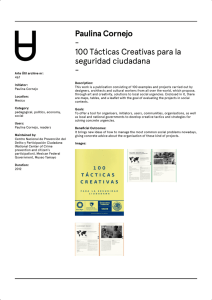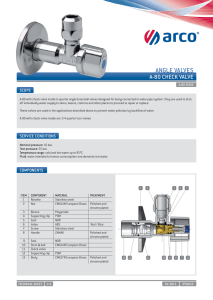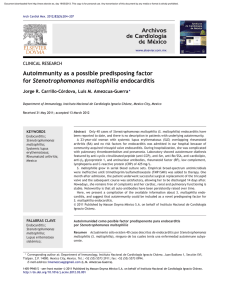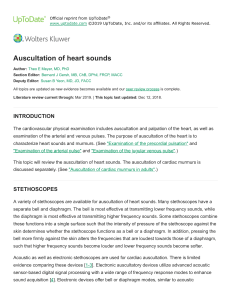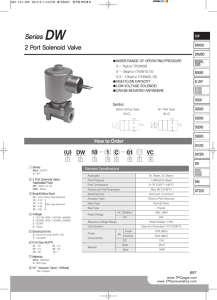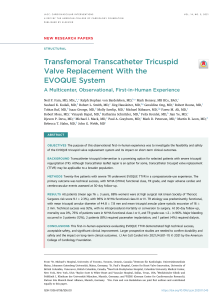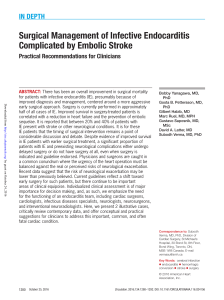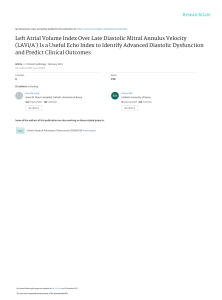Infective Endocarditis: Cause or Consequence of Delayed Anterior
Anuncio
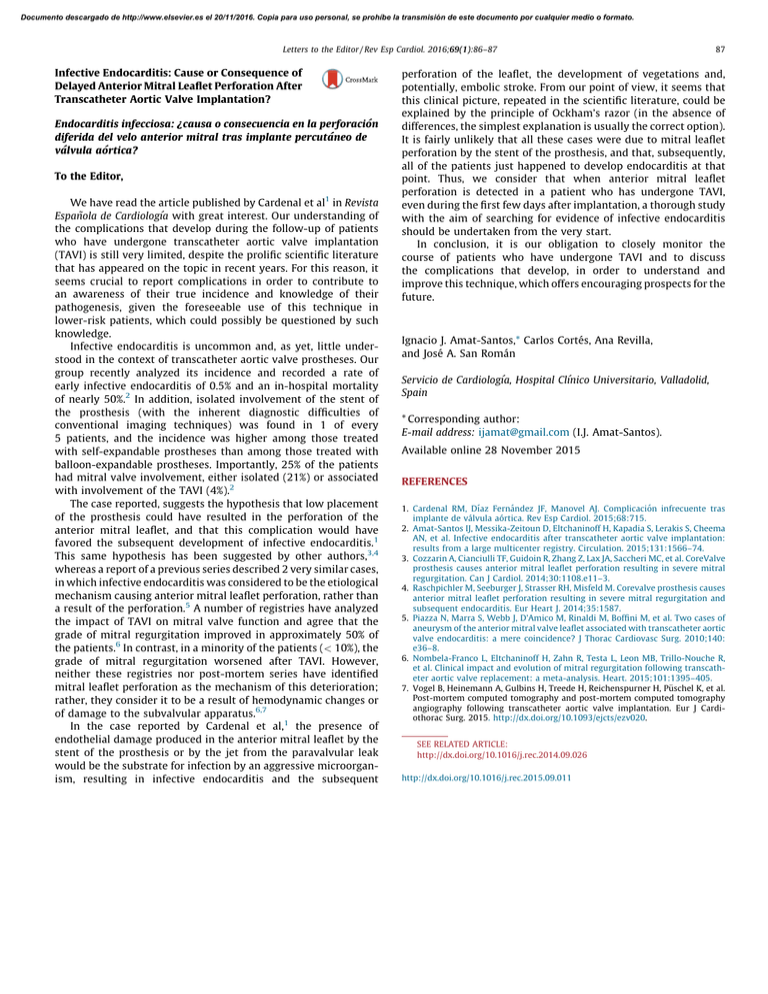
Documento descargado de http://www.elsevier.es el 20/11/2016. Copia para uso personal, se prohíbe la transmisión de este documento por cualquier medio o formato. Letters to the Editor / Rev Esp Cardiol. 2016;69(1):86–87 Infective Endocarditis: Cause or Consequence of Delayed Anterior Mitral Leaflet Perforation After Transcatheter Aortic Valve Implantation? Endocarditis infecciosa: causa o consecuencia en la perforación diferida del velo anterior mitral tras implante percutáneo de válvula aórtica? ? To the Editor, We have read the article published by Cardenal et al1 in Revista Española de Cardiologı´a with great interest. Our understanding of the complications that develop during the follow-up of patients who have undergone transcatheter aortic valve implantation (TAVI) is still very limited, despite the prolific scientific literature that has appeared on the topic in recent years. For this reason, it seems crucial to report complications in order to contribute to an awareness of their true incidence and knowledge of their pathogenesis, given the foreseeable use of this technique in lower-risk patients, which could possibly be questioned by such knowledge. Infective endocarditis is uncommon and, as yet, little understood in the context of transcatheter aortic valve prostheses. Our group recently analyzed its incidence and recorded a rate of early infective endocarditis of 0.5% and an in-hospital mortality of nearly 50%.2 In addition, isolated involvement of the stent of the prosthesis (with the inherent diagnostic difficulties of conventional imaging techniques) was found in 1 of every 5 patients, and the incidence was higher among those treated with self-expandable prostheses than among those treated with balloon-expandable prostheses. Importantly, 25% of the patients had mitral valve involvement, either isolated (21%) or associated with involvement of the TAVI (4%).2 The case reported, suggests the hypothesis that low placement of the prosthesis could have resulted in the perforation of the anterior mitral leaflet, and that this complication would have favored the subsequent development of infective endocarditis.1 This same hypothesis has been suggested by other authors,3,4 whereas a report of a previous series described 2 very similar cases, in which infective endocarditis was considered to be the etiological mechanism causing anterior mitral leaflet perforation, rather than a result of the perforation.5 A number of registries have analyzed the impact of TAVI on mitral valve function and agree that the grade of mitral regurgitation improved in approximately 50% of the patients.6 In contrast, in a minority of the patients (< 10%), the grade of mitral regurgitation worsened after TAVI. However, neither these registries nor post-mortem series have identified mitral leaflet perforation as the mechanism of this deterioration; rather, they consider it to be a result of hemodynamic changes or of damage to the subvalvular apparatus.6,7 In the case reported by Cardenal et al,1 the presence of endothelial damage produced in the anterior mitral leaflet by the stent of the prosthesis or by the jet from the paravalvular leak would be the substrate for infection by an aggressive microorganism, resulting in infective endocarditis and the subsequent 87 perforation of the leaflet, the development of vegetations and, potentially, embolic stroke. From our point of view, it seems that this clinical picture, repeated in the scientific literature, could be explained by the principle of Ockham’s razor (in the absence of differences, the simplest explanation is usually the correct option). It is fairly unlikely that all these cases were due to mitral leaflet perforation by the stent of the prosthesis, and that, subsequently, all of the patients just happened to develop endocarditis at that point. Thus, we consider that when anterior mitral leaflet perforation is detected in a patient who has undergone TAVI, even during the first few days after implantation, a thorough study with the aim of searching for evidence of infective endocarditis should be undertaken from the very start. In conclusion, it is our obligation to closely monitor the course of patients who have undergone TAVI and to discuss the complications that develop, in order to understand and improve this technique, which offers encouraging prospects for the future. Ignacio J. Amat-Santos,* Carlos Cortés, Ana Revilla, and José A. San Román Servicio de Cardiologı´a, Hospital Clı´nico Universitario, Valladolid, Spain * Corresponding author: E-mail address: [email protected] (I.J. Amat-Santos). Available online 28 November 2015 REFERENCES 1. Cardenal RM, Dı́az Fernández JF, Manovel AJ. Complicación infrecuente tras implante de válvula aórtica. Rev Esp Cardiol. 2015;68:715. 2. Amat-Santos IJ, Messika-Zeitoun D, Eltchaninoff H, Kapadia S, Lerakis S, Cheema AN, et al. Infective endocarditis after transcatheter aortic valve implantation: results from a large multicenter registry. Circulation. 2015;131:1566–74. 3. Cozzarin A, Cianciulli TF, Guidoin R, Zhang Z, Lax JA, Saccheri MC, et al. CoreValve prosthesis causes anterior mitral leaflet perforation resulting in severe mitral regurgitation. Can J Cardiol. 2014;30:1108.e11–3. 4. Raschpichler M, Seeburger J, Strasser RH, Misfeld M. Corevalve prosthesis causes anterior mitral leaflet perforation resulting in severe mitral regurgitation and subsequent endocarditis. Eur Heart J. 2014;35:1587. 5. Piazza N, Marra S, Webb J, D’Amico M, Rinaldi M, Boffini M, et al. Two cases of aneurysm of the anterior mitral valve leaflet associated with transcatheter aortic valve endocarditis: a mere coincidence? J Thorac Cardiovasc Surg. 2010;140: e36–8. 6. Nombela-Franco L, Eltchaninoff H, Zahn R, Testa L, Leon MB, Trillo-Nouche R, et al. Clinical impact and evolution of mitral regurgitation following transcatheter aortic valve replacement: a meta-analysis. Heart. 2015;101:1395–405. 7. Vogel B, Heinemann A, Gulbins H, Treede H, Reichenspurner H, Püschel K, et al. Post-mortem computed tomography and post-mortem computed tomography angiography following transcatheter aortic valve implantation. Eur J Cardiothorac Surg. 2015. http://dx.doi.org/10.1093/ejcts/ezv020. SEE RELATED ARTICLE: http://dx.doi.org/10.1016/j.rec.2014.09.026 http://dx.doi.org/10.1016/j.rec.2015.09.011



